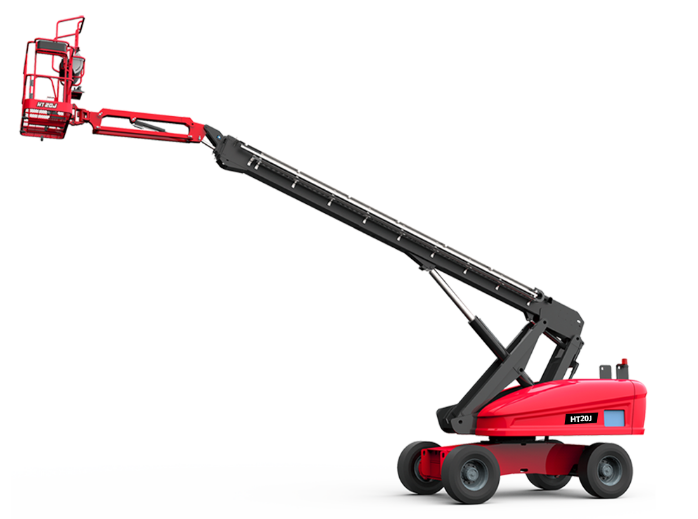Advantages of a Small Telescopic Boom Lift
When looking for a small aerial lift, you'll find a variety of types and sizes, each with its own specifications and performance features. In this article, we'll explore the differences between these small aerial lifts and highlight the benefits they offer.
The Various Small Aerial Lifts on the Market
The most common small aerial lifts on the market include:
1. The Scissor Lift
The scissor lift is a popular choice for tasks like rack construction and indoor maintenance, such as replacing lights in large halls.
Key Advantages: It is relatively affordable, easy to transport, features a spacious work basket, and can be operated at height.
Key Disadvantages: It is less effective for outdoor use, only works well on flat surfaces, lacks leveling capabilities, and offers no horizontal outreach (limited to vertical movement only).
2. The Compact Crawler Boom Lift
The compact crawler boom lift is commonly used by painters and window cleaners due to its versatility.
Key Advantages: It offers a high working range and significant outreach. Its stability is enhanced by stabilizer legs, allowing for a lighter construction.
Key Disadvantages: It requires a substantial amount of space for stabilization (around 100 square feet), cannot be driven at height, and moving it is time-consuming. Additionally, it may feel less stable and is less intuitive to operate.
3. The Towable Boom Lift
The towable boom lift is often utilized for façade cleaning and by window cleaners.
Key Advantages: It is easy to transport behind a truck, works well on flat and hard surfaces, eliminates the need for a separate trailer, and provides a high working range.
Key Disadvantages: It has limited maneuverability on rough terrain, requires substantial space for stabilization, is challenging to position, and takes considerable time to move and stabilize.
4. The Vehicle-Mounted Lift
The vehicle-mounted lift is commonly employed by municipalities for tasks like green space and infrastructure maintenance.
Key Advantages: It can be operated with a standard driver’s license, is versatile for various applications, offers a high working range, and is easily transported without the need for a trailer.
Key Disadvantages: It requires stabilizer legs for operation, cannot be driven while elevated, has limited maneuverability on rough terrain, and occupies significant space in the truck, reducing the room available for materials and tools.
5. The (crawler) telescopic boom lift
The telescopic boom lift (including the HYRAX 27.41) is suitable for a wide range of terrains and professional groups.
Key advantages of this type of aerial lift: easy to transport behind the truck, can drive on any surface due to its non-marking tracks, can work on sloping surfaces, can drive at height, large outreach, maneuverable.
Key Disadvantages: As a lightweight (tracked) telescopic boom lift without stabilizer legs, its working height and outreach can be limited. However, it performs excellently with a working height of up to 41 feet.
What Are the Benefits of a Small Telescopic Boom Lift?
Easy to Transport
Most small telescopic boom lifts are designed for easy transport. Their compact dimensions allow them to be transported on a trailer behind a truck, leaving additional space for other materials and tools.
Access to Tight Spaces
A small telescopic boom lift excels in reaching challenging and narrow spaces that are difficult for larger models to access.
User-Friendly Operation
Smaller telescopic boom lifts are more maneuverable and flexible compared to their larger counterparts. The Hered telescopic boom lift features an innovative control panel with proportional control, allowing for precise speed adjustments rather than simple on/off operation.
Maximized Space for Materials
The compact size of the Hered telescopic boom lift ensures that it occupies minimal space, providing ample room for other materials and tools—an advantage when heading to job or construction sites.
Lightweight Design
The Hered tracked telescopic boom lift stands out in its class for its balanced weight, allowing for higher speeds due to its lighter design.






